Sacked, prosecuted, exposed: A proud history of muckraking
The Age’s investigative reporters have brought down public officials, revealed corruption, and uncovered organised crime operations and war crimes. As the masthead turns 170, we celebrate their journalism.
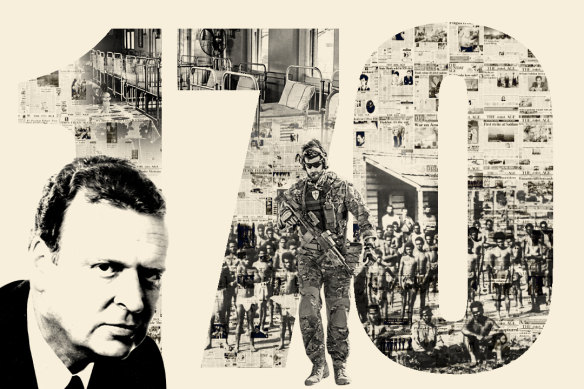
The Age has a proud history of investigative journalism.Credit: Marija Ercegovac
When a young Graham Perkin was appointed editor and charged with reinvigorating The Age in 1966, he set his sights high. While tomorrow’s news would remain the focus, he also did something brave and, it turns out, permanent: he endowed a small but talented team of journalists with a news organisation’s most precious commodity – time – and told them to start muckraking.
“If there is mud to be raked, it is a newspaper’s responsibility to get in and rake it, because there are few other institutions in the community which can do it,” Perkin said later.
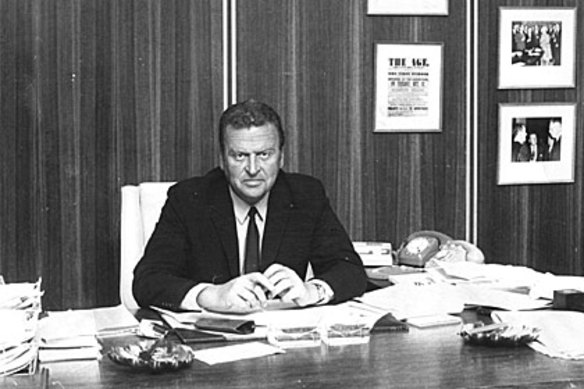
Graham Perkin at the editor’s desk at The Age.Credit: The Age Archives
Under him, investigative journalism became – and remains – a cornerstone of The Age’s compact with its readers. And the orders have not changed much. In 1967, Perkin asked his Insight team, John Tidey and John Larkin, to “keep bureaucracy [and] governments under test” in the service of “representing the public”.
Insight and its successors – now known simply as The Age’s investigative unit – have since revealed public corruption and war crimes. They have drawn attention to Aboriginal deaths in custody, the mistreatment of people with disabilities, failings in public policy and medicine, financial wrongdoing, egregious abuses carried out by religions, unions, developers and businesses big and small.
The reporting has sparked dozens – perhaps hundreds – of public inquiries and royal commissions, brought about significant policy change and led to many corrupt politicians, public servants and business people being disciplined, sacked, prosecuted or resigning in disgrace.
Perkin might have named and formalised investigative journalism at The Age, but he did not invent it. And nor does it exist only within the investigations team. The roots of this kind of journalism are planted deep in the culture of the newsroom – among its business, crime, world and sports teams. Here are five highlights.
‘Blackbirding’: Exposing the Queensland slave trade
In 1882, a young George Morrison, having failed his intermediate medical exam, decided to try his hand at journalism. So, not announcing he was a journalist, Morrison booked passage on the Lavinia, a ship bound for Vanuatu as part of the “blackbirding trade”, in which Pacific islanders were brought, allegedly freely under contract, to work in cutting cane and cotton in rural Queensland.
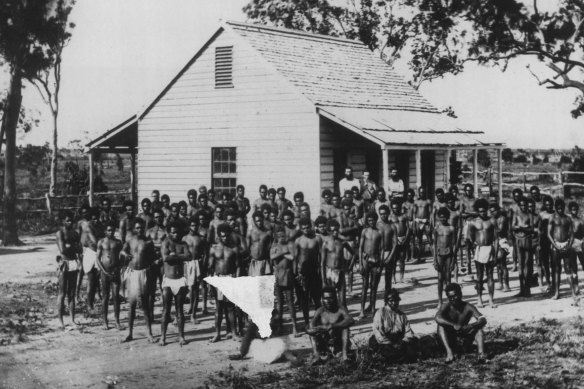
Kanakas from various Pacific islands on a Queensland plantation during the blackbirding days early in the 20th century.Credit: Fairfax Media
On his return in October that year, Morrison published his findings in The Age’s then-weekly magazine, the Leader. The first cut of the story painted a fairly benign picture. But six months later he had another go, describing blackbirding as a “Queensland slave trade”.
He laid out the trickery involved in getting islanders to sign contracts, including that the workers were often intimidated by rifles, and shot at if they tried to jump ship to escape. He said there was a “fearful death rate” from disease and, for the women unlucky enough to be brought to Australia, the ships became, in Morrison’s words, “veritable brothels”.
An Age editorial thundered that for Australia to condone blackbirding meant the “curse of forced labour” would imperil the country’s future. Remember, the American Civil War had been fought over slavery just 20 years earlier, almost splitting that country in two.
Morrison’s journalism prompted a full-scale government inquiry in Queensland, where it was initially dismissed by the premier, but backed by the governor. Some reforms followed, but the trade was hardy. It did not stop until more than 20 years later, when Queensland’s desire for cheap labour was finally eclipsed by the racism of the White Australia policy.
‘The Minus Children’ of Kew Cottages
When society hairdresser Lillian Frank bailed up Perkin in 1973 and started talking about the appalling conditions children with disabilities were enduring in Melbourne’s Kew Cottages, he initially did not believe her.
As former Age investigative journalist Ben Hills tells it in his book Breaking News, Frank described a boy living there who was “bandaged to his chair because he ate his hands”, and others “lying on the floor … flies all over them”.

A ward at Kew Cottages, 1973. Credit: The Age Archives
Perkin dispatched his Insight team of Hills and John Larkin to investigate. They found the former “Kew Idiot Asylum” had 920 residents, making it the largest such institution in Australia – but there was little education or therapy, a tiny daily meal allowance and, overwhelmingly, a culture of neglect.
Under the title “The Minus Children”, the story described a “lost, lonely landscape with great empty spaces outside, while inside the wards there was terrible overcrowding, with beds jammed up against each other, bathrooms that would not rate as car washes, and children sitting and lying around listlessly, some silent, some screaming their lungs out, some hyperactive, some slumped in a heap in the corner”. There was, Larkin wrote, nothing for them to do except wait for the next meal.
A year later, the government had done little, so Larkin wrote a follow-up series. When the government still failed to act, Perkin launched an appeal – personally participating in door-knocking – to raise money. The then-Liberal government of Rupert Hamer eventually promised to match whatever it raised – which turned out to be $1.1 million – $12.3 million in today’s dollars.
Three months later, Perkin died – he did not live to see the new building at the cottages that was named after him. It was not enough to end the horror, unfortunately. After deep budget cuts in the 1990s, a fire took hold of one building in 1996, killing nine of the residents.
The Age Tapes
In 1984, Age investigative journalist Lindsay Murdoch received a late-night tip-off. A NSW police whistleblower had given crime writer Bob Bottom a cache of illegally recorded phone taps that revealed a web of influence at the highest levels of Australia’s political and legal systems.
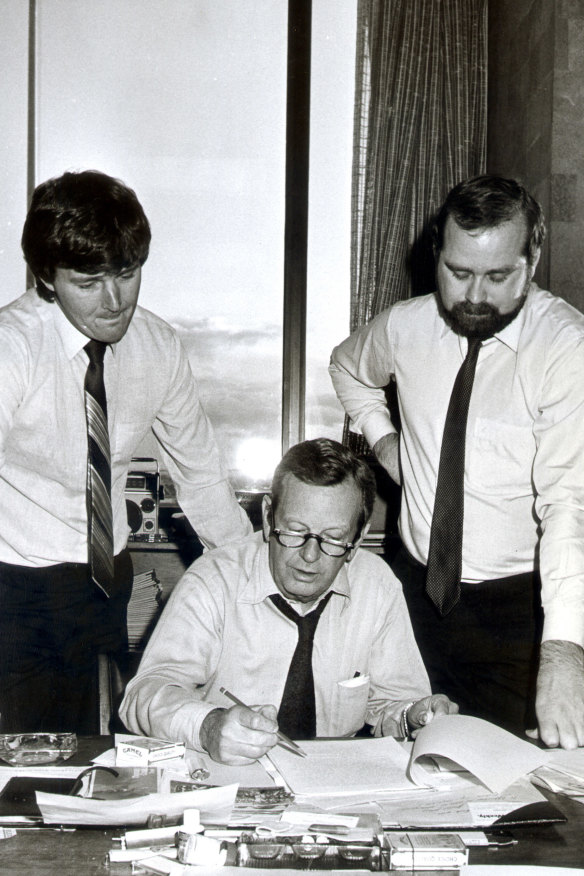
Age editor Creighton Burns flanked by reporters David Wilson (left) and Lindsay Murdoch.Credit: The Age
The allegations, dubbed The Age Tapes, and reported diligently and voluminously by Murdoch and the head of the Insight team, David Wilson, implicated no lesser person than High Court judge and former Labor attorney-general Lionel Murphy. The tapes revealed his sometimes-lewd conversations with a Sydney solicitor, Morgan Ryan, who was acting at the time for Sydney’s leading crime figure, Abe Saffron – known widely as Mr Sin.
On the tapes, Murphy allegedly called Ryan “my little mate”.
As associate editor and senior writer Tony Wright wrote recently, an outcry followed from the NSW government of Neville Wran, and federal Labor’s Gareth Evans, about alleged breaches of privacy.
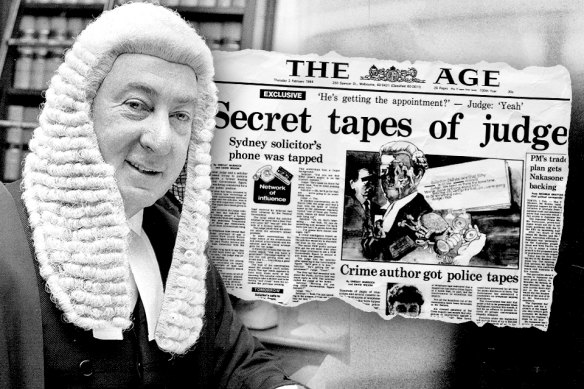
Lionel Murphy and the front page of The Age on February 2, 1984.Credit: The Age
The tapes prompted two parliamentary inquiries into Murphy, then two criminal trials – though neither ultimately led to a guilty verdict. Murphy died before a parliamentary inquiry could determine whether he was fit to sit on the High Court.
The tapes, though, featured much more than just the judge and the solicitor. The 524 pages of transcripts and police reports covered 3980 tapped conversations and related to the activities of some of Australia’s most dangerous criminals at the time, including mafia dons and a professional hitman dubbed “Mr Rent-a-Kill”.
The tapes – and the tips and revelations that followed – cracked open a world of organised crime that Bottom, working with Wilson and Murdoch on The Age Insight team, assiduously exposed.
Banking bad
Few institutions are as wealthy, intimidating complicated and crucial to our lives as Australia’s big banks. When they go bad, they can wreak enormous damage.
In June 2013, Adele Ferguson and Chris Vedelago, investigative business reporters at The Age, told an astonishing tale about how financial advisers had gone bad in Australia’s biggest and most trusted bank, the Commonwealth.
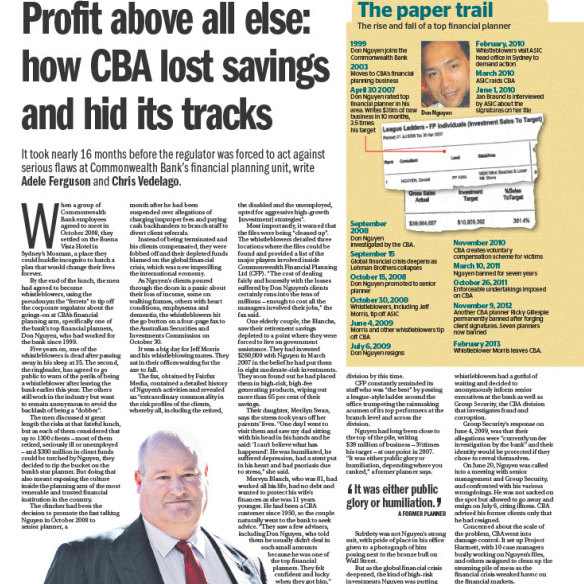
The first of many stories exposing the Commonwealth Bank’s misdeeds.Credit: The Age
Financial advisers – pumped up by a hot-house sales culture featuring strip clubs and fancy meals – had pushed thousands of retirees and people with health problems into high-risk financial products, then had allegedly forged signatures, created unauthorised investment accounts and overcharged them for fees.
When the whole thing came crashing down, costing ordinary investors tens of millions of dollars, bank staff tried to cover up the mess, and escape liability, by falsifying documents.
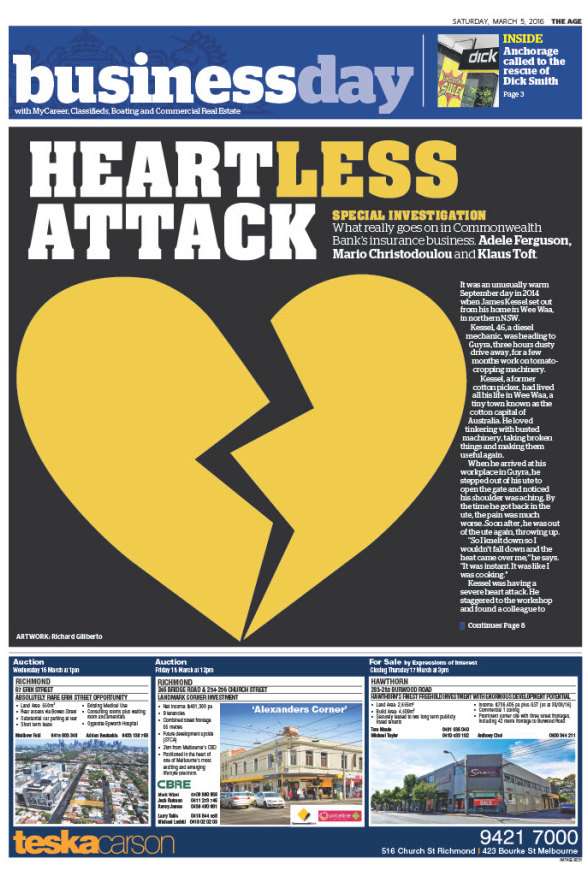
The Comminsure investigation.Credit: The Age
Two years after that scandal broke, Ferguson was back again, this time in collaboration with Four Corners, to blow up Commonwealth Bank’s insurance arm, CommInsure.
In that story, in March 2016, Ferguson revealed how the bank’s insurance arm was dodging its liabilities with out-of-date definitions for disease, leaning on medical officers to change their opinions and using unethical tactics to delay payouts.
Between these two stories – and others – the government, in December 2017, was forced to announce a royal commission into the banks. It showed bad behaviour, including charging dead people for advice or even life insurance, was endemic across the industry.
The war crimes of Ben Roberts-Smith
When 20-something-year-old Nick McKenzie arrived at The Age in 2006 and was promoted directly into the investigative team, then-editor Andrew Jaspan was taking a risk. But in the 18 years since, McKenzie has proved himself one of the most prolific, dogged and fearless reporters The Age has seen.
True to Perkin’s vision, with a number of collaborators over the years – including Richard Baker – he’s raked muck on the mafia, a corrupt global organisation working across the oil industry, organised crime in the building union, Victoria’s emergency services system, the Chinese Communist Party and its patsies in Australia and many, many more.
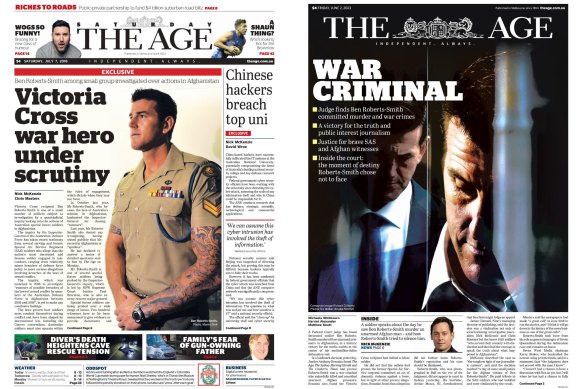
From left: The start of the investigation into Ben Roberts-Smith and the defamation trial judgment day report.Credit: The Age
But Australia’s most decorated living soldier – a Victoria Cross recipient, father of the year and Seven News executive – was among the biggest. In 2017, launching an investigation into Ben Roberts-Smith, Australia’s Afghanistan-era uber-soldier, for war crimes was extraordinarily brave.
Even then, McKenzie did the work with collaborator Chris Masters. They amassed evidence in forensic detail and convinced dozens of whistleblowers to talk, despite the legally enshrined code of silence that binds the SAS. They verified and cross-checked facts; they accessed sources and witnesses in war-torn Afghanistan.
By June 2018, despite the clear legal risks, they brought it all to the point of publication.
Their reporting was tested over months of a subsequent defamation trial – called the trial of the century. And when Federal Court Justice Anthony Besanko delivered his findings in 2023 – five years after the first stories were written – that reporting was vindicated. Roberts-Smith is appealing the judgment.
The Age has much to be proud of. At the top of that list must be its long and storied tradition of raking mud on behalf of the public.
Start the day with a summary of the day’s most important and interesting stories, analysis and insights. Sign up for our Morning Edition newsletter.